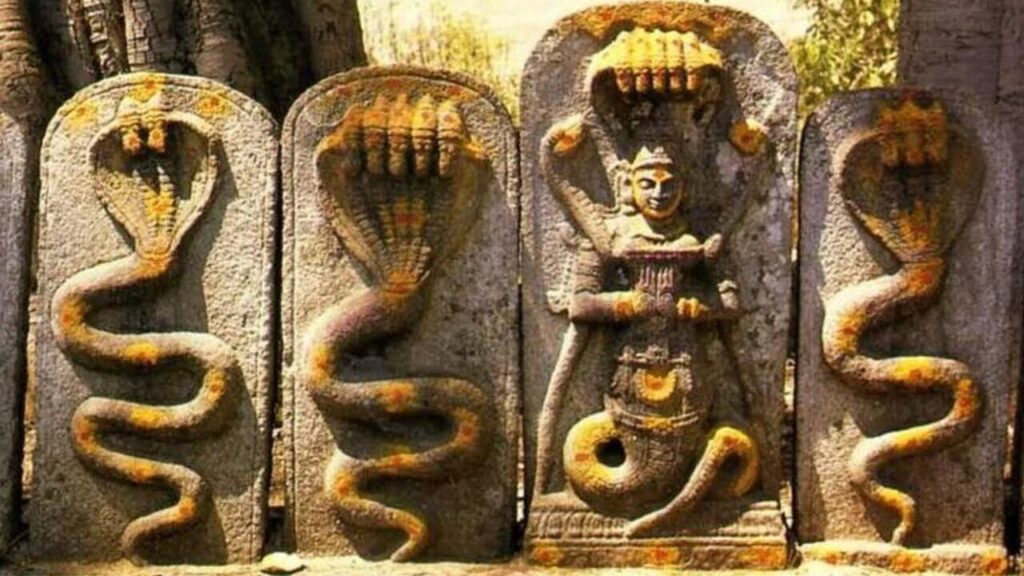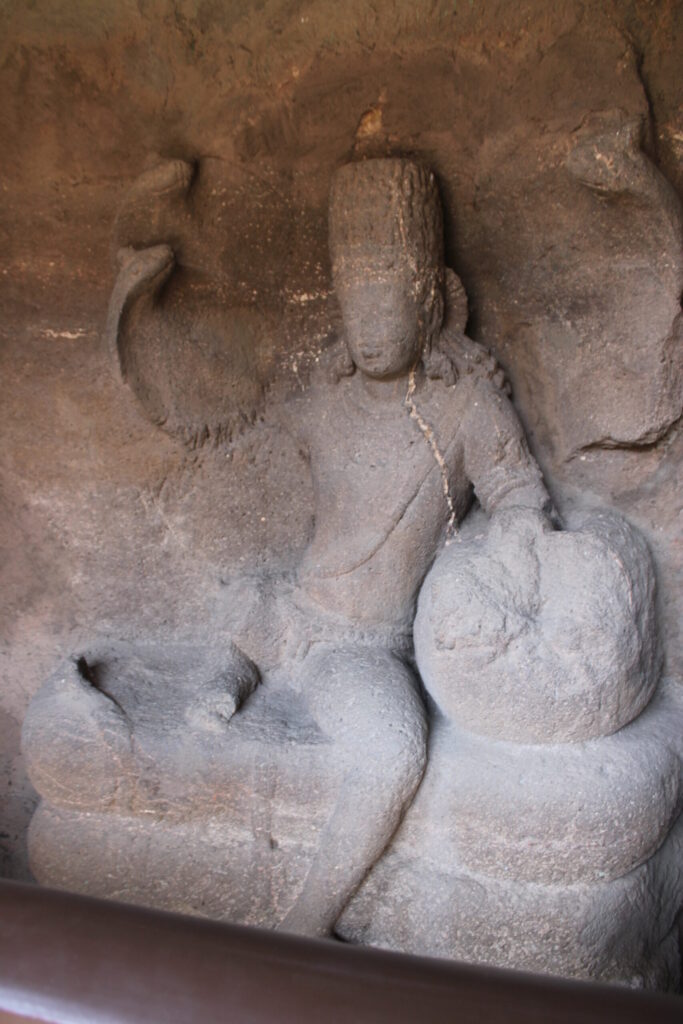Snakes, the spineless creatures, alias, Nagas in our land, are virtually present almost everywhere—below the ground, under the sea; in the lakes and springs; on the mountains; on the trees, in the burrows; and even in the skies. In India, snakes exist in the subcontinent’s ancient texts, mythologies, folklore, tribal worship, art, and architecture.
Found across Hinduism, Buddhism, and Jainism, these serpentine figures are not merely animals but sacred entities tied deeply to mythology, cosmology, and symbolism. From guarding treasures to supporting the cosmos, their imagery speaks volumes about ancient Indian views on nature, the afterlife, and spiritual power. Naga worship or serpent Worship (also known as Ophiolatry) has been present since the ancient period.
Across cosmic metaphors, spiritual activities, heavenly characteristics, and ecological care, snake iconography in India is multifaceted and profoundly meaningful. In Indian visual culture, snakes serve as either defenders, destroyers, or awakeners, reflecting the level of civilisation in a society that finds divinity in both the natural and the supernatural. Their frequent appearance in writings, temples, and customs reflects a worldview that reverently and artistically honors life’s secrets.

1. Nāga as Cosmic Entities
Nāgas, in Hindu and broader South Asian cosmologies, are revered as powerful cosmic entities embodying the dynamic forces of nature, particularly those linked to water, fertility, and the subterranean realms. Far from being mere serpents, they are often semi-divine beings who dwell in the hidden realms beneath the earth and oceans — realms rich with treasures and ancient wisdom. Symbolically, nāgas bridge the earthly and cosmic, representing both primal instincts and spiritual awakening. Their serpentine form reflects the cyclic, coiled nature of time and energy, much like Kundalini in yogic traditions. As guardians of cosmic balance, Nāgas are associated with rain, rivers, and subterranean vitality, ensuring the continuity of life. In mythology, they serve both as protectors and challengers — divine reminders of nature’s dual aspect: nurturing yet unpredictable, concealed yet potent.

2. Kundalini Serpent in Yogic and Tantric Symbolism
In Yogic and Tantric traditions, the Kundalini serpent represents the primal energy of consciousness, coiled like a dormant serpent at the base of the spine in the Muladhara (root) chakra. This sacred energy, known as Kundalini Shakti, is considered the feminine force of the universe — pure potentiality waiting to be awakened. When stirred through disciplined spiritual practice such as yoga, meditation, and mantra, the Kundalini rises through the Sushumna nadi, piercing the seven chakras and uniting with Shiva at the Sahasrara (crown) chakra, symbolizing the union of matter and spirit. This ascent is both transformative and transcendental, dissolving the ego and revealing higher states of consciousness. The serpent imagery reflects both the coiled latency of this power and its awakening force — a divine fire that can liberate or destabilise, depending on the seeker’s readiness. In Tantric texts, the awakened Kundalini is not merely symbolic but a lived mystical experience, signifying inner illumination and the realization of the Self.
3. Divine Companions and Symbols of Power
In Hindu iconography and mythology, serpents — particularly Nāgas — often appear as divine companions and potent symbols of power, intricately woven into the narratives of deities. These serpents are not merely protectors but manifestations of divine energy, representing control over primal forces and mastery of nature. For instance, Lord Vishnu rests upon the cosmic serpent Shesha Nāga, illustrating his sovereignty over time and the universe. Similarly, Lord Shiva wears a cobra around his neck, symbolizing fearlessness, inner awakening, and the cyclical rhythm of creation and destruction. Even Lord Krishna is depicted subduing the serpent Kaliya, a gesture of divine dominance over chaos and ignorance. In these depictions, serpents serve as both guardians and emblems of cosmic order, spiritual power, and transformation. Their presence beside deities emphasizes the harmony between the elemental and the divine, where serpents, often feared in the material world, become sacred bearers of protection, wisdom, and enlightenment in the spiritual realm.

4. Temple Guardians and Architectural Symbols
In sacred architecture across South and Southeast Asia, serpents — particularly Nāgas — serve as powerful temple guardians and symbolic protectors of sacred space. These serpent forms are often carved into temple gateways, stairways, and lintels, acting as liminal beings who guard the threshold between the mundane and the divine. In Hindu and Buddhist temples, nāgas are not just decorative but deeply symbolic, representing the flow of spiritual energy and the protection of cosmic order. Their undulating, serpentine forms lining staircases often signify the ascent toward enlightenment, guiding devotees upward through the spiritual path. In many traditions, Nāga balustrades also symbolise rivers or cosmic waters, reinforcing their association with life-giving energies and fertility. Their fierce expressions and coiled bodies signal their role as defenders against evil and ignorance, ensuring that only the pure of heart may enter sacred spaces. This architectural symbolism transforms stone into a sacred presence, merging art, myth, and cosmic meaning into every corner of the temple.
5. Nāgas in Buddhist Tradition
In Buddhist tradition, Nāgas hold a revered place as powerful semi-divine beings who serve as guardians of the Dharma and custodians of hidden wisdom. Unlike their often fearsome portrayal in Western symbolism, nāgas in Buddhism are both protective and enlightened, frequently associated with water, fertility, and subterranean realms. One of the most iconic representations is the Nāga Mucalinda, who rises from beneath the earth to shield the meditating Buddha with his multi-headed hood during a storm — a profound symbol of spiritual protection and inner serenity amidst turmoil. Nāgas are also credited in Buddhist lore with preserving esoteric teachings and sacred scriptures, particularly in Mahāyāna and Vajrayāna traditions, where they are believed to guard hidden treasures (terma) that are revealed to worthy beings at the right time. Their dual nature — serpentine and divine — mirrors the Buddhist understanding of taming inner passions and transforming them into awakened energy. In this way, nāgas embody a union of natural and spiritual forces, revered as allies in the path to enlightenment.

6. Jain Representations: Subtle Symbolism
In Jainism, Nāgas appear with more subtle and symbolic nuances, reflecting the tradition’s emphasis on non-violence, spiritual purity, and inner asceticism. Unlike their more elaborate roles in Hindu and Buddhist contexts, serpents in Jain iconography are often associated with specific Tirthankaras (spiritual teachers), particularly Parshvanatha, the 23rd Tirthankara, who is traditionally depicted with a multi-hooded serpent canopy over his head. This serpent, often interpreted as Dharanendra, represents divine protection and spiritual awakening. The imagery is not about power or conquest but instead illustrates spiritual steadfastness and the triumph of ascetic virtue over adversity. According to Jain texts, Dharanendra rose to shield Parshvanatha during his deep meditation, symbolising the natural world aligning with ascetic purity. In this context, the Nāga is less a cosmic force and more a symbol of inner transformation, subtle guardianship, and the harmonious relationship between sentient beings and the spiritually evolved. Jain art thus integrates the Nāga not as a dominating force but as a silent protector of deep meditative insight and non-attached wisdom.
7. Folk Traditions and Ritual Art
In folk traditions across India and Southeast Asia, Nāgas are deeply woven into the fabric of ritual art, local legends, and agrarian spirituality, where they are revered as fertility deities, rain-bringers, and guardians of land and water. Unlike their grand mythological roles in religious texts, folk representations of Nāgas are often more intimate and community-centred. Rural communities worship Nāgas during seasonal festivals, especially in regions dependent on monsoon rains, offering milk, turmeric, and flowers at serpent shrines or carved stones known as Nāga stones. These rituals seek blessings for crop fertility, family protection, and safe childbirth. In art forms like patachitra paintings, terracotta sculptures, and floor drawings (kolam or rangoli), serpents are rendered with vibrant creativity, reflecting local styles and storytelling traditions. In South Indian and tribal traditions, Nāga worship blends seamlessly with ancestor veneration, symbolising the continuity of life and lineage. This folk veneration emphasises the serpent not as an object of fear but as a benevolent guardian and life-giver, bridging nature, spirit, and society in everyday ritual life.
Conclusion
The serpent in Indian iconography is far more than a creature of myth — it is a profound symbol of cosmic balance, spiritual transformation, and divine protection. Whether coiled beneath Vishnu as Shesha Nāga, rising as Kundalini within the yogic body, guarding temple thresholds, or sheltering the meditating Buddha, the snake represents forces both primal and transcendent. Across Hinduism, Buddhism, Jainism, and regional folk traditions, serpents are honoured not only for their power but for their sacred presence in nature and the human spirit. Their duality — at once earthly and divine, feared and revered — mirrors the deeper truths of Indian philosophy, where life is a journey through cycles, energies, and enlightenment. Through the serpent’s many forms, Indian art and ritual invite us to explore the hidden currents that shape existence, reminding us that what slithers in the shadows can also be a bearer of light.

Anusha Chaudhary holds an M.A. in History and has a keen academic and creative interest in Indian art, aesthetics, iconography, and heritage studies. With a passion for exploring the visual and symbolic dimensions of South Asian traditions, she delves into the cultural narratives that shape sacred spaces, rituals, and artistic expressions with a deep commitment to preserving and interpreting India’s rich visual heritage through thoughtful research and storytelling.
